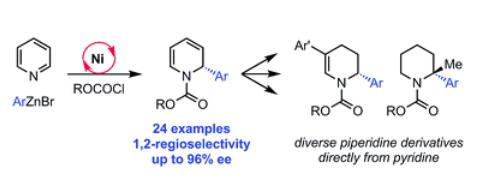New reaction turns feedstock chemical into versatile, chiral building block

Researchers in the Doyle lab at Princeton have developed a direct and selective cross-coupling reaction that employs a chiral nickel catalyst and an activating agent at low temperatures to couple nucleophilic arenes, common motifs in bioactive compounds, with a feedstock chemical known as pyridine. Credit: Doyle lab
Researchers in the Doyle lab at Princeton have developed a direct cross-coupling reaction to produce nitrogen-containing compounds called 1,2-dihydropyridines, versatile building blocks that are highly useful in pharmaceutical research.
Published in Chemical Science, the reaction employs a chiral nickel catalyst and an activating agent at low temperatures to couple nucleophilic arenes, common motifs in bioactive compounds, with a feedstock chemical known as pyridine.
“A highlight of the method is being able to use pyridine as a substrate because it's inexpensive and abundant and has rarely been used in transition metal and asymmetric catalysis,” said Abigail Doyle, an associate professor of chemistry at Princeton and corresponding author of the article.
Performing transition metal chemistry with pyridine has proven challenging because it can 'poison' the nickel catalyst, essentially binding to the nickel such that the reaction cannot move forward. The research team found that they could overcome this limitation by adding a slight excess of an activating agent, a compound known as iso-butylchloroformate. This addition favors the formation of an intermediate species that will not bind to the catalyst and allows the reaction to proceed.
The method is also highly enantio- and regioselective, meaning that researchers could control the precise geometry and position at which the new chemical bond is formed between the two coupling partners, attractive features that have not been offered by previous methods.
The researchers went a step further by demonstrating the utility of the product by performing nine different elaborations commonly used by medicinal chemists in drug development. “That was my favorite part to do,” said Patrick Lutz, a graduate student in the Doyle lab and lead author of the paper. “Optimization is necessary, and exciting when you find ways to improve the reaction, but it was really fun thinking about all the different types of reactions that I could do.”
###
Read the full article here:
Lutz, J. P.; Chau, S. T.; Doyle, A. G. “Nickel-catalyzed enantioselective arylation of pyridine.” Chem. Sci. 2016, Advance article.
This work was supported by the National Institutes of Health National Institute of General Medical Sciences (R01 GM100985) and a National Science Foundation Graduate Research Fellowship to J.P.L (DGE-1148900).
Media Contact
All latest news from the category: Life Sciences and Chemistry
Articles and reports from the Life Sciences and chemistry area deal with applied and basic research into modern biology, chemistry and human medicine.
Valuable information can be found on a range of life sciences fields including bacteriology, biochemistry, bionics, bioinformatics, biophysics, biotechnology, genetics, geobotany, human biology, marine biology, microbiology, molecular biology, cellular biology, zoology, bioinorganic chemistry, microchemistry and environmental chemistry.
Newest articles

High-energy-density aqueous battery based on halogen multi-electron transfer
Traditional non-aqueous lithium-ion batteries have a high energy density, but their safety is compromised due to the flammable organic electrolytes they utilize. Aqueous batteries use water as the solvent for…

First-ever combined heart pump and pig kidney transplant
…gives new hope to patient with terminal illness. Surgeons at NYU Langone Health performed the first-ever combined mechanical heart pump and gene-edited pig kidney transplant surgery in a 54-year-old woman…

Biophysics: Testing how well biomarkers work
LMU researchers have developed a method to determine how reliably target proteins can be labeled using super-resolution fluorescence microscopy. Modern microscopy techniques make it possible to examine the inner workings…





















